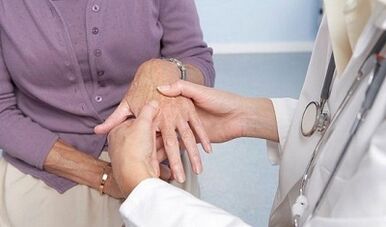
Arthritis and arthrosis are often confused because of the similarity of their names. Yes, and both diseases affect the joints (for example, there is arthritis and arthrosis of the knee joint). The affected joints become inflamed, swollen and sore. Otherwise, this is a completely different disease. Let’s try to determine how arthritis differs from arthrosis?
The difference between arthritis and arthrosis
Arthritis is accompanied by inflammation of the articular joints, which in turn causes impaired motor function. The patient experiences discomfort, he experiences acute aches or pains, both during physical activity and during rest, especially in the morning. The skin around the joints swells, turns red and becomes tense. Body temperature often rises. Arthrosis is a disease in which a degenerative process occurs in the articular cartilage. The altered cartilage ceases to bear the load falling on it and is gradually destroyed. The pain caused by exercise usually disappears at rest. The tissue around the joint becomes swollen and inflamed. Progressive disease leads to cartilage destruction and severe joint deformity. The difference between arthrosis and arthritis lies in the cause of the disease. Arthrosis occurs:
- primary, usually associated with old age;
- secondary, arising from other diseases or genetically determined.
Predisposing factors for the development of arthrosis are:
- overweight;
- excessive physical activity (most often, in athletes) or very low physical activity;
- past injuries;
- endocrine diseases.
Arthritis is inflammation. There are causes of diseases such as:
- various infections;
- joint damage and recurrent minor injuries;
- metabolic disorders;
- allergies;
- lack of trace elements and vitamins.
Analysis for arthritis and arthrosis
For early diagnosis of diseases affecting supportive devices, specialists need to compile a full anamnesis. Patients are invited to pass the following tests and perform the prescribed examinations:
- Clinical blood tests to determine ESR levels (with arthritis, the rate of erythrocyte sedimentation increases significantly, with arthrosis approaching normal).
- Biochemical blood tests to identify macro and micronutrient deficiencies, characteristic of arthritis.
- X-rays to help detect bone defects inherent in arthrosis and determine the width of the joint space.
- MRI (magnetic resonance imaging), which allows you to identify changes in cartilage tissue in the early stages of the disease.
The cause of the disease
The main difference between arthritis and arthrosis is the origin of the disease. Arthritis is an infectious disease that causes inflammation of the joints. Arthrosis is a degenerative process that occurs in the body as a result of the natural wear and tear of the joints and aging, which results in the destruction of the cartilage layer in the joints. Thus, arthrosis is a hallmark of the elderly, and arthritis can be contracted at any age, even in childhood. Women are more likely to have arthritis. Osteoarthritis affects women and men who have reached old age. Most often, arthritis is caused by:
- various infections;
- allergic reactions;
- joint damage;
- frequent minor injuries;
- physical stress;
- metabolic disorders;
- vitamin and mineral deficiencies;
- autoimmune disorders;
- diseases of the nervous system.
In addition, arthritis often develops as a complication of arthrosis, but not the other way around. Osteoarthritis is mainly caused by:
- genetic predisposition;
- inadequate blood supply and bone nutrition;
- excessive pressure on the joints;
- joint injuries;
- hypothermia.
Symptoms of joint disease
Although both diseases are accompanied by painful sensations, these sensations arise in different conditions. With arthritis, pain appears both during physical exercise, and during sleep and in the morning. With arthrosis, pain worries a person only during physical exercise.
Another characteristic difference between arthritis and arthrosis is the nature of the pain. Arthritis is characterized by sharp, strong and wrinkled pain, and dull and painful arthrosis, accompanied by pain.
Arthritis most often affects small joints, and arthrosis - large joints (especially the knees and hips). Arthrosis only affects the joints. In arthritis, the inflammation can spread to some joints as well as other organs. In addition, arthritis is accompanied by fever, swelling and redness in the affected area. Sometimes with arthritis, subcutaneous rheumatic nodules appear. Over time, arthrosis leads to deformity of the joint, which can become thinner and have a strange shape.
Diagnostics
For diagnosis, similar methods are used (X-rays, computed tomography, laboratory tests), but the results will be different. In arthritis, a complete blood count will show an increase in erythrocyte sedimentation rate and high concentrations of C-reactive proteins, leukocytes and seromucoids. With arthrosis, such an analysis will not detect abnormalities.
Treatment of arthritis and arthrosis
Various specialists are involved in the treatment of the disease. Arthrosis is treated by an orthopedic traumatologist, and in the case of arthritis, the cause of the disease is first determined, and then, depending on it, a specialist is selected. The disease is treated by the same method, using medication and physiotherapy. If the disease is too far away, then surgery is used - endoprosthetics or joint replacement. But there are also some differences in the treatment of the disease. Arthritis requires immediate and active therapy, and arthrosis requires long -term and comprehensive treatment. Arthritis treatment begins with dietary and lifestyle changes. Then the patient is given anti-inflammatory drugs and antibiotics, as well as physiotherapy procedures. Osteoarthritis is treated with hormonal, anti-inflammatory and analgesic medications. Arthritis is generally completely cured, and arthrosis, which is a chronic disease, causes irreversible consequences on untreated joints - it is only possible to slow down the degenerative process.
These two diseases have similar consonant names because they are symptoms of rheumatism. However, don’t get confused: arthrosis is a mechanical disease, and with arthritis, the joints become inflamed. In simpler terms, if the joint pain swells, the patient develops arthritis. If the pain in the joint is weak, then it is arthrosis. In this article we will try to explain in accessible language how it differs. For those unfamiliar with medicine, it is difficult to distinguish between the two. Because both of these diseases are directly related to rheumatism. Both of these diseases cause pain and discomfort in the joints, which become immobile. The symptoms of this disease, as well as how to treat it, are very different.
What is the difference between arthritis and arthrosis?

The difference between arthritis and arthrosis is that with arthritis, the joints become inflamed. As a result, the enzyme is released, which leads to its destruction. They form proteins that unite them. This is one of the causes of pain. Often it happens when someone is asleep. With physical exercise, it subsides a bit. Weakness is felt in the morning. The disease affects the joints of the legs and arms.
Arthritis can have different causes. For example, septic arthritis is caused by an infection, and rheumatoid arthritis is caused by a decrease in immunity. Gout develops due to metabolic disorders.
Joint changes occur along with physiological changes. As a result, the skin may become warm or red.
How is arthritis treated?
To cure it, it is necessary to reduce symptoms and restore joint mobility. To do this, it is recommended to try various methods. They can be combined if necessary. This will help determine the best one. Also, with this disease, blood test results are different. With arthrosis, protein levels increase. If the patient has arthritis, there is no change in blood composition. When choosing a medication used to get rid of such problems, one must take into account the type of disease. Often used for healing:
- corticosteroids;
- biological and anti-inflammatory drugs;
- analgesic;
- anti-irritant drugs;
- antirheumatic drugs;
- methods of therapy.
Physical activity is needed to heal. With specialized exercises, you can strengthen joints and strengthen muscles. Sometimes staples or splints are used for this purpose. If other methods of therapy do not help, the doctor recommends removing the damaged joint. They are replaced with artificial ones. Often, the knee is treated this way. Such operations are performed to relieve discomfort and restore their activity. After this procedure, the destruction of the joint is slower. In addition, with surgical methods, it is customary to perform surgery to cut the articular tissue. At the same time, foreign particles are removed from its shell. The patient undergoes such an operation to smooth the rough surface and change the pressure angle.
How is arthrosis treated?

To cure this disease, you need to reduce your risk factors. Those who are overweight are advised to eat properly. Patients need to monitor their diet. This is especially true for those who have undergone surgery for bone structural pathology.
If the patient's condition does not improve, you can get rid of the problem using anti-inflammatory and analgesic drugs. In order not to have to use a prosthesis, the patient should be given hyaluronic acid. It will also help relieve discomfort.
You cannot completely reduce physical activity. Exercise is definitely easy for your health. This should prevent weight gain. If you have a suspicion of a particular disease, do not panic and do not try to cure it yourself. Timely diagnosis and properly prescribed treatment increase your chances of a quick recovery.
The main difference
As mentioned above, arthrosis is a mechanical disease. With that, the articular cartilage periodically shrinks until it disappears. As a result, the rubbed bone is exposed. It occurs mainly in the elderly. In this case, the patient noted certain special features related to the appearance of the joint. As a rule, he has the following reasons related to injuries, abnormalities of bone structure, overweight. Often, it affects the pelvic and knee joints. Often damages the joints of the neck and spine. Unlike arthritis, arthrosis can cause significant discomfort while moving. The difficulty disappears between walking, running, and so on. But apart from the unpleasant sensation, it cannot manifest itself in the form of inflammation, hence it is often called a "cold" disease.













































